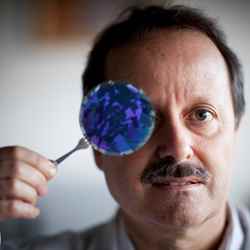Professor Leigh Canham
Winner: 2020 Spiers Memorial Award
University of Birmingham
For pioneering work in silicon quantum dots and contributions to practical applications of silicon nanostructures in the electronics, photonics and biomedical fields.
Celebrate Professor Leigh Canham
#RSCAwards
Professor Canham’s research explores how the semiconductor silicon behind the electronics in your mobile phone, computer, car and so on can be modified to have new and useful properties. Two examples are silicon emitting light efficiently and being medically biodegradable. The group do this by creating really tiny nanocrystals (under five nanometres wide) out of the big crystals (15 centimetre wide “silicon wafers”) used in electronics. They then etch billions of tiny closely-spaced holes (pores) into solid silicon to leave silicon nanowires and nanocrystals. Highly porous networks of these nanocrystals have huge surface areas (like a football pitch in one gram), so surface chemistry has a huge influence on their behaviour, in addition to their size and shape.
Silicon is a very abundant element in the environment. Certain plants, called “silicon accumulators” by botanists, take silicon-based molecules from soil and make silica nanostructures in their stems, leaves or husks. Examples are bamboo, sugarcane and rice. Professor Canham is very interested in utilising these natural systems to generate large quantities of silicon nanostuctures, that not only have novel properties, but are also inexpensive and can be used in developing countries to tackle problems that affect huge numbers of people. Examples of such problems are drinking water of poor quality, vector-borne diseases like malaria, inexpensive solar cells and antimicrobial resistance.
Read full biography
